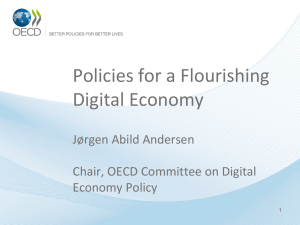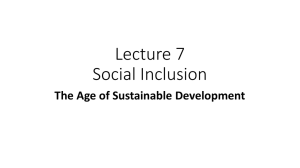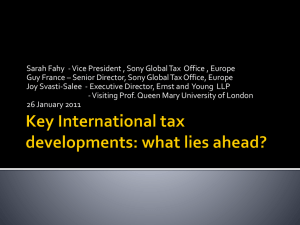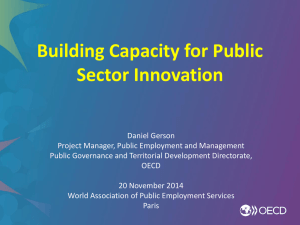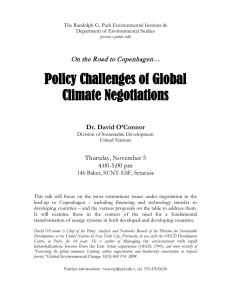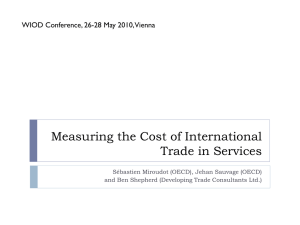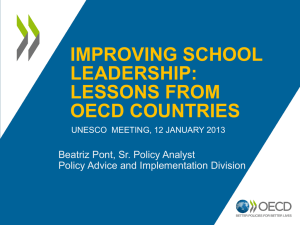Government policies on ICTs, the environment and climate change (“Green ICTs”)
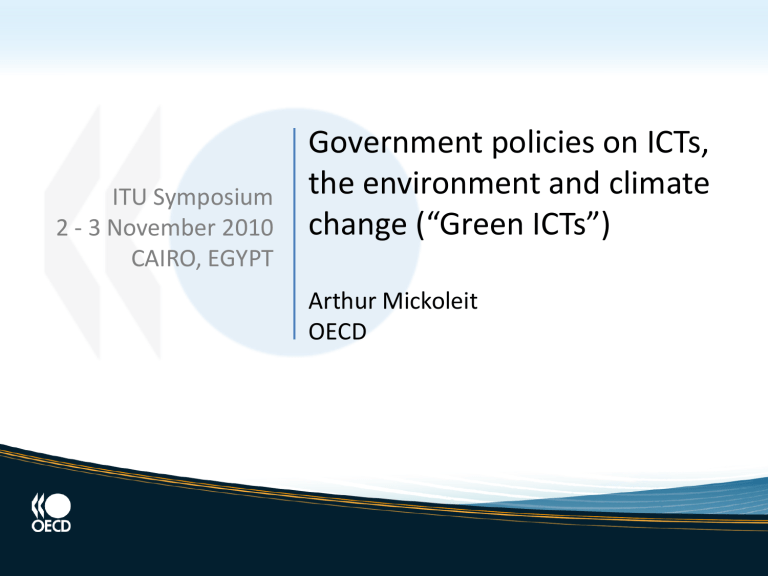
ITU Symposium
2 - 3 November 2010
CAIRO, EGYPT
Government policies on ICTs, the environment and climate change (“Green ICTs”)
Arthur Mickoleit
OECD
Structure
1. Net environmental impacts of Green ICTs
2. Comprehensive approaches, example of the cloud
3. OECD country policies
4. Applicability of OECD and EC recommendations in developing countries ?
5. Conclusions
1. Net environmental impacts of Green ICTs
Paper production and use
%
160
150
140
130
120
110
100
1990 1992 1994 1996 1998 2000 2002 2004 2006 2008
Smart agricultural irrigation
Rare metals in ICT goods
Source: OECD, 2010, “Greener and Smarter.
ICTs, the environment and climate change”.
1. Global paper production
%
160
150
140
130
120
A digital revolution that did not happen ?
Or is it ?
110
100
1990 1992 1994 1996 1998 2000 2002 2004 2006 2008
Source: OECD calculations based on FAO, ForesSTAT, May 2010
2. Comprehensive policy approaches – example of the cloud
Individual server
• Improved utilisation
• Power management
• Efficient components
Data centre
• Consolidation
• Virtualisation
• Buildings design
• Power supply
Systemic change
2. Comprehensive policy approaches – example of the cloud
Cloud computing has much systemic environmental potential:
• Development aspect: “Leapfrogging” to government and business applications hosted by regional cloud providers in regional data centres.
• Decarbonisation aspect: Ad-hoc re-routing via the clouds can help
“shave” peaks in electricity demand.
• Dematerialisation aspect: Digital content, e.g. music and games.
globally ONE QUARTER of music is bought online
i.e. without CD or case (think energy, plastic, waste).
3. OECD country policies
So what are governments doing?
3. OECD country policies - 2009
60
40
20
0
120
100
80
Direct effects
Enabling effects
R&D and Design Manufacturing Distribution Use Disposal
Source: OECD, 2009, “Towards Green ICT Strategies:
Assessing Policies and Programmes on ICT and the Environment”.
3. OECD country policies – 2010
Priority Policy area
1.
Security of information systems and networks
2. Broadband diffusion
3. Government on-line
4. ICT R&D programmes
5. Innovation networks and clusters
6.
Enabling environmental impacts of
ICTs
# OECD countries with high priorities
23
22
22
18
18
10
# OECD countries with increased priorities
11
10
8
11
8
16
Green Growth
Source : Based on the policy questionnaire of the
OECD Information Technology Outlook 2010 (forthcoming)
3. OECD country policies – examples
Emerging good practice: tackling direct and enabling impacts jointly, researching systemic impacts.
Direct Enabling Systemic
United States
“National BB Plan”
Germany
“Germany Green
IT Pioneer”
Netherlands
“ICT+Energy”
Federal government data centres
Federal govt IT energy use by 2013:
- 40%
FCC + DoE & DoT: energy and transport policy objectives
E-energy: pilot regions for smart grids and e-transport
Long-term agreements to limit energy use in
ICT sector and co-develop solutions for energy and transport sectors.
Accompanying research for eenergy
4. OECD and EC Recommendations
R&D
Green ICT skills
Policy evaluation
Life cycle
Govt leadership
Best practices
Measurement
Awareness
Public procurement
4. …for emerging economies ?
An open question for this discussion.
Some common characteristics, but also differences:
• Electronic waste : from import to domestic generation
• Diesel back-up power in telecommunications networks
• Smart grid – how to combine with general objectives for electricity provision?
• Regional cloud computing centres – green energy, reliable energy
5. Conclusions
Three takeaways
1. Partnerships inciting and including the ICT sector – arguably the most innovative sector there is
2. Communicate and co-ordinate a. Within ICT policy community b. With environmental, energy, etc. policy communities
3. Climate change is big, but…
1. energy efficiency not equal saving the climate
2. water scarcity – the next big issue
3. biodiversity and land loss reach farther than that
4. adverse health effects
Thank you
www.oecd.org / sti / ict / green-ict
Arthur.Mickoleit @ oecd.org
